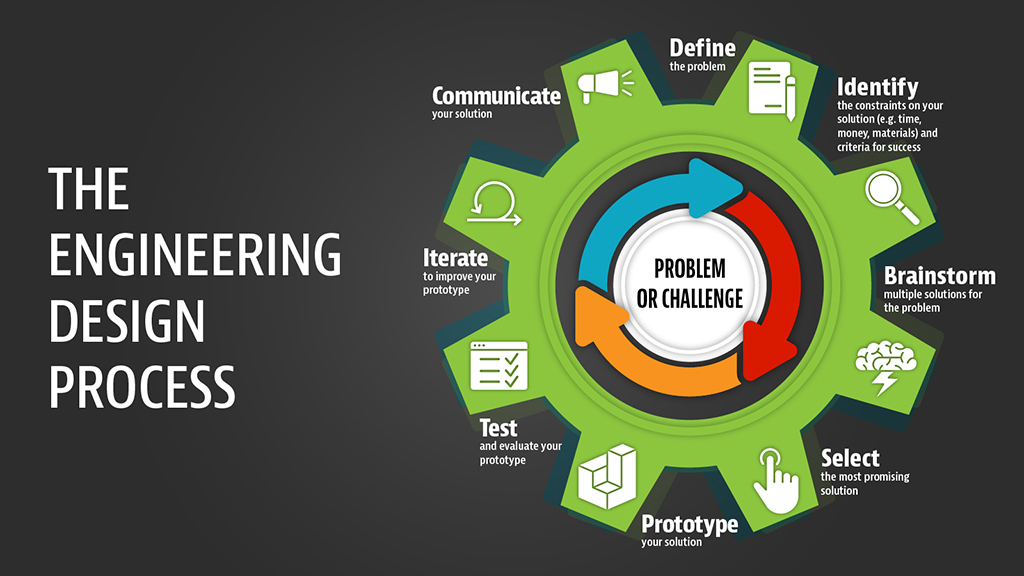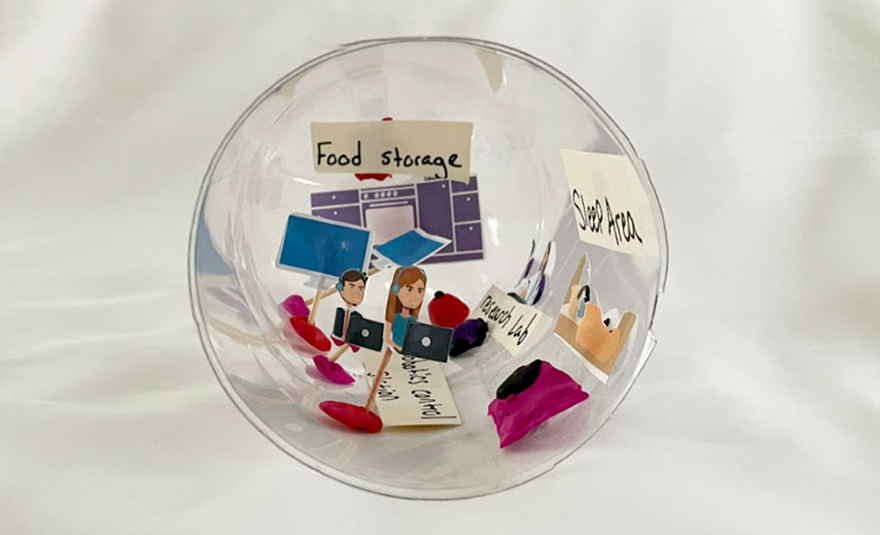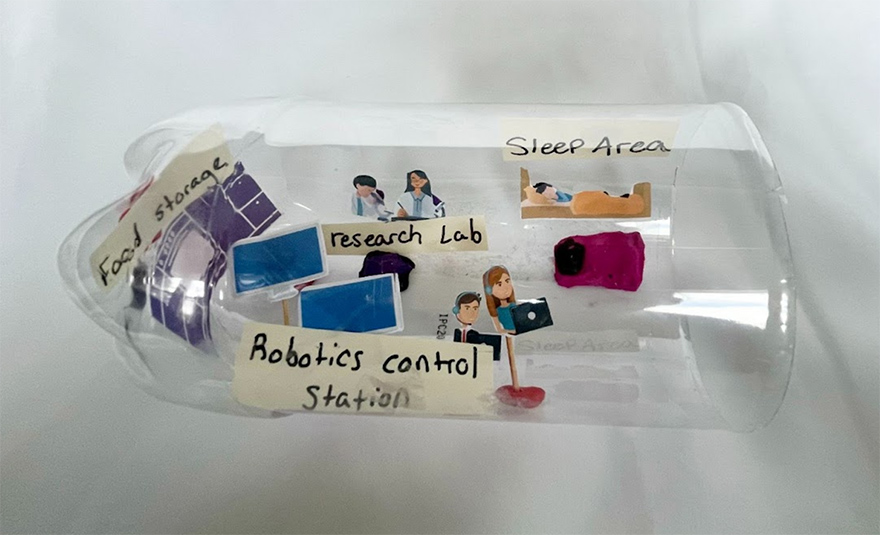Say Hello to HALO!
Using an engineering design process as well as cardboard, recycled plastic, and other repurposed materials, imagine and build your version of the HALO (Habitation and Logistics Outpost) habitat in space. Your version of HALO needs to accommodate two astronauts, and let them do four important things while maintaining a positive work/life balance. This activity can be done alone or in small groups.

Text version of infographic entitled "The engineering design process"
The engineering design process
- Problem or challenge
- Define the problem
- Identify the constraints on your solution (e.g. time, money, materials) and criteria for success
- Brainstorm multiple solutions for the problem
- Select the most promising solution
- Prototype your solution
- Test and evaluate your prototype
- Iterate to improve your prototype
- Communicate your solution
Infographic entitled "The engineering design process". (Credit: Canadian Space Agency [CSA])
Define
Astronauts will have limited space on the Lunar Gateway. The Lunar Gateway will be made from a few different sections, or modules, and when connected together will be the size of two small school buses. The two astronauts will be stationed on the HALO, which will only be the size of one small bus. They will need to perform experiments, command the Gateway, eat, rest, and exercise in this very small space.
Learn about Canada's role in the Lunar Gateway!
Identify
Where do astronauts sleep, eat, and work when they are onboard the Lunar Gateway? If you built your very own HALO, what would you put in it? Make a list of your "needs
" and your "wants." You may not have space for everything, so this will help you decide what is most important for the astronauts in a small space.
Suggested materials
- Cardboard or construction paper
- Fasteners (elastics, binder clips, brads, pipe cleaners, string, tape, glue, or homemade glue)
- Scissors or cardboard cutters
- Hot glue gun (optional)
- Graph paper or regular paper
- Any repurposed materials you have on hand (plastic bottles, egg cartons, straws, Popsicle sticks, small twigs, rocks, etc.)
- Variety of paints, coloured paper, crayons, pencil crayons, markers, tinfoil, or any other materials available to make your HALO look awesome!

Text version of infographic showing a few cardboard cutting and folding techniques
A few cardboard cutting and folding techniques
- Flange
- L-brace
- Tabs
- Slot + cut
- Slot + tab
- String
A few cardboard cutting and folding techniques. (Credit: CSA)
Brainstorm
How is living on Earth different from living in space? Think about your everyday life. How would it change if you lived in space on the HALO? How would the lack of gravity in outer space have an effect on your design? Could you use this to help maximize space in your HALO? What makes living in space difficult? Discuss the answers to these questions and come up with a few solutions.
Brainstorm what parts the HALO should have for the astronauts to be able to work and be happy. Sort these into wants or needs.
| Number | Wants | Needs |
|---|---|---|
| 1 | - | - |
| 2 | - | - |
| 3 | - | - |
| 4 | - | - |
| 5 | - | - |
| 6 | - | - |
| 7 | - | - |
| 8 | - | - |


Example of a HALO and its components seen from the front and side. (Credit: CSA)
Select
How will you fit all of the astronauts' needs inside the design? What do you need to live and survive in space? What can you live without?
Using the wants vs. needs list you just made, what should be the four most important parts of your HALO design?
| Number | Most important parts of your HALO design |
|---|---|
| 1 | - |
| 2 | - |
| 3 | - |
| 4 | - |
Prototype
- Using your list, draw a picture, or diagram, of what your HALO would look like inside. Circle the four most important parts.
- Gather a variety of recyclables to use as construction materials. Maybe you can find a box, or cardboard, or clear plastic bottles in the recycling bin. Take a look at the suggested cardboard designs to help bring your ideas to life.
- What shape will your HALO be? The real HALO will be a cylinder, which is like a circle that has been stretched. Why can some shapes be better than other shapes?
- Find an area in your HALO for your wants and needs, but remember to use your list of the four most important parts.
- Be creative and add details to each section and area to make it unique and match the design you sketched earlier.
- Add labels to your constructed HALO that identifies each important part.
- Measure the length and width of your HALO using non-standard units (toothpicks, paper clips, nickels, etc.) or standard units (ruler).
Test
How can you make sure there is room for all the essentials? What can you do to ensure that two astronauts can move around the HALO safely? Do you think your HALO will survive the trip to space and be able to orbit (go around) the Moon without items inside causing damage?
Improve
Look closely at your prototype for ways that its design can be improved.
- What changes will need to be made to accommodate more astronauts?
- What happens if an astronaut has a medical emergency?
- What will the astronauts do if they have a problem or experience a mechanical failure?
- How will additional modules (sections) be added?
- What will power the HALO?
Communicate
- Give a grand tour of your HALO. Share a typical day in the life of the astronauts onboard.
- What are the most important parts of your HALO? Are you particularly happy with a specific part?
- If you had to make a new one, would you do anything differently?
- Share your project with the CSA. Ask an adult to share a picture on social media and tag the CSA accounts. You never know: a real astronaut or engineer might see your creation!
Taking it further
- Use Lego to build your HALO, a model of the Lunar Gateway, or example of how other space vehicles or modules can connect to the HALO.
Learn about simple machines and add some moving parts to your construction.
Note to educators: The children can design their HALO using software or apps like Scratch, TinkerCad or other platforms.
- Write or draw a poem, a story, a song or a play about astronauts living on the HALO.
- Read books to get inspired to design the most fantastical space habitat you can imagine. You can add as many "
needs
" and "wants
" as you like! - Role-play as an astronaut and pretend you are living in the HALO. What jobs would an astronaut do?
- Role-play as an astronaut and pretend you are getting ready to perform a spacewalk outside the Lunar Gateway.
Curriculum links
- Mathematics:
- Measurement
- non-standard measurement
- standard measurement
- Measurement
- Wants/needs
- Diagrams, sketching, and mapping
- Creativity, critical thinking and problem solving, communication, collaboration
